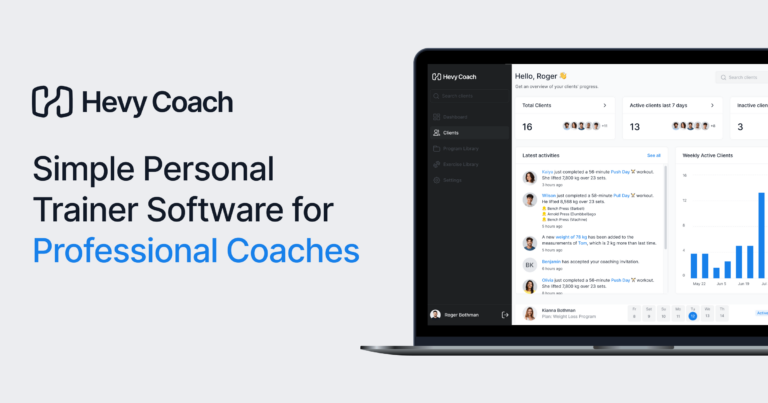Personal trainers are fitness experts who guide people along their fitness journeys, helping them reach their goals safely and on time.
However, while the profession is fulfilling and engaging, it comes with its fair share of risks and liabilities.
So, stick around and read our guide because it breaks down personal trainer insurance and teaches you everything you need to know to protect yourself on the job––from understanding the importance of insurance to choosing the right kind, we’ve got you covered.
Is Personal Trainer Insurance Necessary?
Personal trainer insurance is essential because it protects you from potential liability claims as a result of a client getting injured or not getting the desired results. Depending on your needs, the insurance can also cover potential property damage, stolen equipment, and an employee’s compensation if they get hurt or sick on the job.
Understanding the Risks: Why Personal Trainers Need Insurance
As briefly mentioned above, running a personal training business has risks. Every day, personal trainers face potential liabilities that could lead to financial losses, a negative impact on their practice and brand, or even legal action.
A common risk is a physical injury during training, which falls under general liability. No matter how good and attentive you are, accidents can happen. For example, the client can slip and fall, get injured because they’ve ignored a persistent ache, or lose control of the weight because of a temporary lapse in focus.
In such a case, you could be held liable and forced to pay their medical expenses.
Another potential risk is professional liability. For instance, let’s say that a client gets injured while following your program or fails to get the desired results. In such a case, they could threaten legal action.
The third common scenario relates to property insurance. Let’s say you’ve rented a studio or are coaching people at home. In such a case, you face additional risks in the form of property damage, theft of training equipment, etc.
Replacing stolen things or fixing property damage can set you back if you don’t have the proper insurance. That said, theft can be nearly impossible to prove, and you might still have to cover any expenses related to missing equipment even if you pay for the right insurance policy.
Having the right insurance coverage in these and many other situations can guard you against financial loss, protect your assets, and allow you to focus on what you do best––helping your clients reach their goals.
Understanding Insurance and the Types of Coverage for Personal Trainers
General Liability Insurance
General liability is perhaps the most critical personal trainer insurance. It protects you from financial losses and legal action in case of a client injury.
For example, imagine that a client is careless at the end of a demanding set, and they throw the dumbbells to the floor. One of them lands on their foot and fractures it. In such a scenario, you could be held liable, even if the accident is not your fault.
General liability insurance covers all the associated costs in such a scenario and protects you from potentially significant financial losses.

Try Hevy Coach
Intuitive personal trainer software, with a world class experience for your clients.
30 day free trial, no credit card required
Professional Liability Insurance
Also known as Errors and Omissions insurance, this coverage benefits personal trainers. It protects you from unhappy clients who find fault with your professional guidance.
Unfortunately, while you may approach your job with the best intentions, unfavorable circumstances can arise, leaving you exposed to potential lawsuits.
Suppose you create a workout program for a client, and they get injured as a result. Maybe one of the exercises is too difficult for them, or perhaps the training volume is too high, but they don’t say anything and decide to push forward.
In such a case, the client can claim that professional negligence was the cause of their injury and decide to sue for damages.
Professional liability insurance would cover all the related expenses and offer peace of mind.
Property Insurance
Property insurance is essential for fitness professionals who own or rent a physical location, such as a studio. As its name suggests, this type of personal trainer insurance protects against property damage that could result for various reasons.
Everything inside your studio or gym (treadmills, free weights, squat racks, etc.) is essential to running your personal training business, and each of these can be subject to vandalism, a natural disaster, or theft.

Additionally, the space itself is also subject to some of these things. For example, a fire nearby could damage your studio and equipment, leaving you open to significant financial losses.
Property insurance offers protection in such scenarios.
Commercial Property Insurance
This type of insurance is similar to the previous one. Still, it is specifically created to offer coverage for personal trainers who rent or lease a space for their business. Depending on the terms of your lease or rent agreement, you could be held liable in case of damage.
For instance, let’s say you’ve rented a small gym, and a significant portion of it gets damaged by a fire or flood. The repair costs could be astronomical, and they might have to come out of your pocket if you lack the appropriate protection.
Workers’ Compensation Insurance
Workers’ compensation insurance is essential for personal trainers and other fitness professionals who employ other people. This coverage is typically required by law and offers protection for the employer and employee in case of injury or illness at the workplace.
Just as clients can slip and fall, drop a weight on themselves, or get injured in another way, employees can also suffer from such unexpected issues. In such a case, the employee might need medical attention and time off work to heal.
Worker’s compensation insurance offers protection by covering medical expenses and compensating the employee for some of the lost wages.
Online Training and Extending Your Coverage Beyond the Gym
Online personal training is relatively new. It began gaining traction around a decade ago and exploded in popularity in the wake of the Covid-19 pandemic. These days, lots of fitness professionals offer their services online, which has its advantages.
However, while there are new opportunities, virtual coaching has also brought some unique and unforeseeable limitations, especially concerning personal trainer insurance.
Online training is inherently different from in-person coaching. It makes it more challenging to determine who might be responsible if a client gets injured or doesn’t get the desired results.
For example, you could provide a good training plan, but your client would have to apply it on their own. In such a case, the only way to be liable is if they thoroughly document their fitness journey and can somehow prove that they’ve followed your instructions down to a T.
Additionally, things become even more obscure when we introduce the geographical reach of online training. Working with people online means you don’t have to limit yourself to clients in your area. You can work with people in other states and countries, often living thousands of miles away.
The best approach is to make sure your personal trainer insurance coverage extends to the places where your online clients live.
Some insurance providers have adapted to the growing popularity of online training and offer specific coverage for online coaches.
Speaking of online personal training, check out Hevy Coach––our all-in-one platform for fitness professionals. It allows you to write programs for clients, make quick adjustments when necessary, keep track of adherence and progress, and much more. The best part? You can do all of that from a single dashboard.
Choosing the Right Insurance Provider: 4 Factors to Consider
1. Reputation and Customer Satisfaction
The first thing to consider when looking for an insurance provider is the reputation and level of customer satisfaction. Their reputation often reveals what you need to know about the company and if they would be the right fit.
You can look at their standing with regulatory bodies (e.g., the Federal Insurance Office), their history, and the company’s financial stability. Also, it’s best to research if the company has been involved in any large scandals and if past clients have sued them.
Read reviews online to get an idea of their customer satisfaction rate and how they compare to other insurance companies.
2. Personal Trainer Insurance Coverage and Flexibility
Coverage options and the flexibility to switch between them is also important to consider.
As with many other services, the options here can vary significantly and depend on many factors, so it’s best to research to find a plan that fits your needs and budget.
First, only consider providers that cover the essentials: general, professional, property, and workers’ compensation liability. If you offer online coaching, ensure the potential provider offers adequate coverage.

Second, opt for an insurer that allows you to easily adjust your insurance plan or add additional policies if you need more coverage.
For example, you might start with general liability insurance but may later need property and workers’ compensation if you lease space and hire other trainers.
3. Cost and Value for Money
The personal trainer insurance cost is one of the first things most people will look at when considering an insurer. However, you must also think about the value you’re getting in return because a lower initial price can end up costing you.
Check if the insurance policy covers all the essentials you need to offer your service and not worry about property damage, a potential employee’s sick leave, or lawsuits. Also, make sure the policy doesn’t include things you don’t need.
For example, you don’t need property insurance if you don’t own, lease, or rent the space where you train people. Similarly, workers’ compensation insurance would be unnecessary if you don’t have employees and don’t plan on expanding anytime soon.
Also, ask if there are any special offers for bundling policies or for professionals in specific organizations (e.g., NASM).
4. Claims Process and Customer Support
Proper and timely customer support can be a lifesaver, especially when you’re in a difficult situation and facing liabilities. Pick a company with straightforward, efficient, and understandable claims processes.
Here are a few tips:
- Research potential companies and see what clients say. Are there patterns of people complaining of poor customer service or excessive payout periods? Use services like Google, Better Business Bureau, and Trustpilot.
- Test it for yourself. Pick up the phone and call the insurance company with some questions. Take note of how long it takes you to get a hold of an operator, how knowledgeable they are, and how willing they are to provide thorough answers.
- Ask for recommendations. Do you know any established personal trainers? Tell them about your services and ask them to recommend good personal training insurance.
- Learn about their claims process. Go on the company’s website and find information on the claims process. The company should be transparent about the whole process and provide in-depth information on how everything happens. Vague or non-existing information on the subject is a red flag.
Getting Started with Insurance for Personal Trainers
As discussed so far, getting the right insurance coverage is a step forward to a safer and less stressful career in the fitness industry. Let’s first do an overview of how the process might look. We will then go over some of the best personal trainer insurance providers.
Personal Trainer Insurance Policy: An Overview
- Assess your needs. Sit down and think about your needs as a personal trainer or business owner. What risks do you face, and what type of coverage would offer all the protection you need?
For instance, if you are a personal trainer and gym owner with one or more employees, you would need general, professional, property, and workers’ compensation insurance. - Research the market. Look at the available insurers to determine who might be the best fit. Read reviews online, check their ratings, research their coverage options and flexibility, and determine if the cost is worth the value. Also, test their customer service (responsiveness, willingness to help, etc.) and look for in-depth information on their claims processes.
Don’t be afraid to reach out to them with specific questions if you need clarification on something. - Gather quotes. Reach out to several companies and ask for quotes based on your needs. Compare the prices and the value you get in return.
- Make the purchase. Once you’ve landed on an insurer, pull the trigger and get the most suitable coverage option.
- Continue reviewing the policy. Your insurance needs can change over time, so it’s essential to check the terms and ensure they fit your services.

Try Hevy Coach
Intuitive personal trainer software, with a world class experience for your clients.
30 day free trial, no credit card required
List of Good Personal Training Insurance Providers
Here is a list of reputable companies offering adequate coverage for fitness professionals. While each can be a good option, it’s always best to do your independent research, especially given the significance of personal trainer insurance.
- NASM (National Academy of Sports Medicine) provides personal training insurance through its partnership with Next Insurance, Inc., a leading fitness professional insurer.
NASM is a reputable organization in the industry and offers some of the best training for people looking to earn a professional certification.
Basic protection from everyday accidents starts at $25 monthly and offers up to $10,000 coverage. Professional liability insurance costs as little as $11 a month. - Insurance Canopy is another excellent option for professionals in need of flexible coverage. The company offers flexible coverage plans, instant protection after the first payment, and the ability to personalize your policy based on your unique needs.
Personal trainers, group fitness instructors, physique fitness trainers, CrossFit instructors, lifestyle coaches, cardio trainers, aerobics instructors, and many other professionals can take advantage of the plans.
Monthly coverage starts from as low as $12.50, and the standard annual plan is $129. - Insure Fitness Group offers comprehensive coverage for personal trainers and other fitness professionals. They provide general liability, professional liability, rental damage, and product liability coverage.
The company also offers online personal training coverage, and its Trustpilot rating is an impressive 4.8 out of 5 stars with 400+ ratings.
Conclusion
Whether you work at a gym, offer your services from home, train people online, or own space, having the right insurance can make a huge difference and improve your bottom line.
For instance, personal trainer liability insurance can protect you from unhappy clients who consider your professional guidance subpar for one reason or another. Similarly, general liability offers coverage and protects your assets in case of a client injury, excluding potential ones that might result from negligence or incompetence.
NASM, Insurance Canopy, and Insure Fitness Group are three fantastic options, each with a proven track record and plenty of satisfied customers.
While the right personal trainer insurance is essential, you must also consider the service you provide and do everything you can to boost client satisfaction. Doing so improves retention rates and helps you sign new clients through word-of-mouth advertising.
To that end, we recommend checking out Hevy Coach––our all-in-one platform for personal trainers and coaches. It lets you keep close track of your clients, answer their questions, deliver training programs, make changes on the go, and much more. The best part is that you can do these and other things from a single dashboard.
FAQs
1. Is my policy valid if I teach at multiple gyms?
Personal trainer insurance policies are typically made portable, which means they cover a specific person rather than being tied to a location (unless we are talking about property insurance).
2. Does my insurance cover online training?
Many policies cover online training, but it’s always best to double-check and ask explicitly before setting up a payment plan.
3. How much does personal trainer insurance cost?
The cost depends on the amount of coverage a personal trainer needs. The basic coverage costs around $20 to 25 a month.




